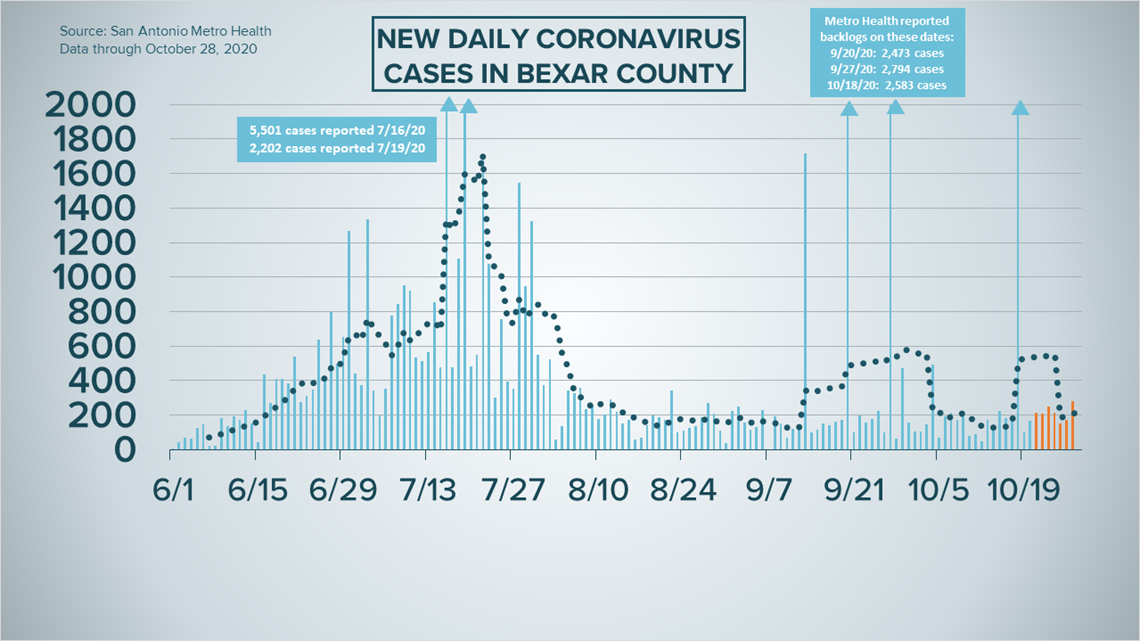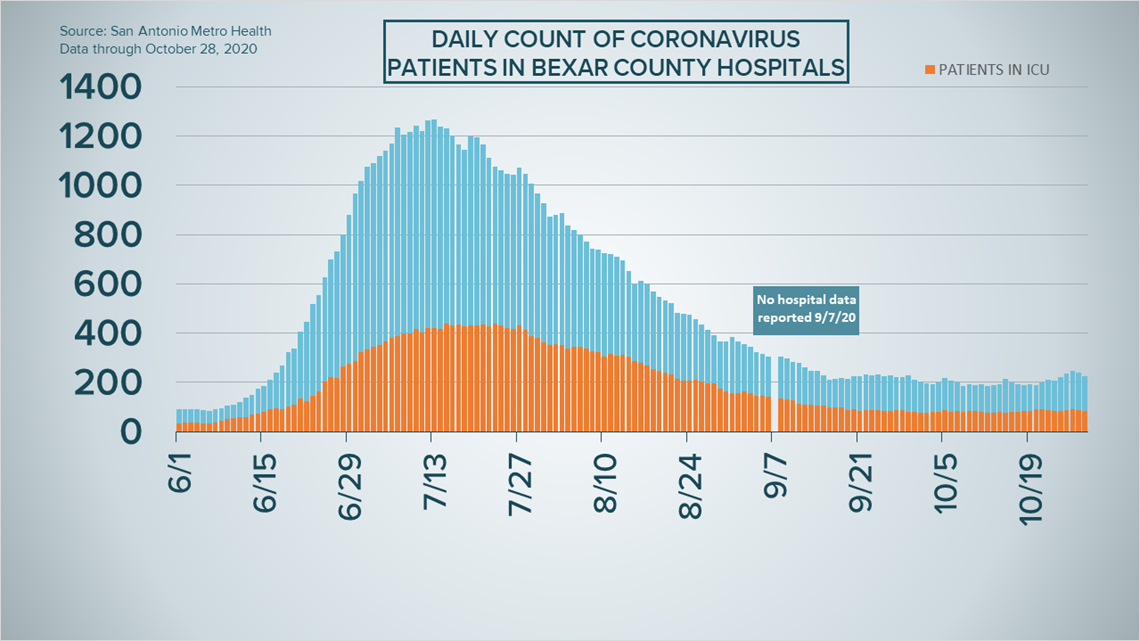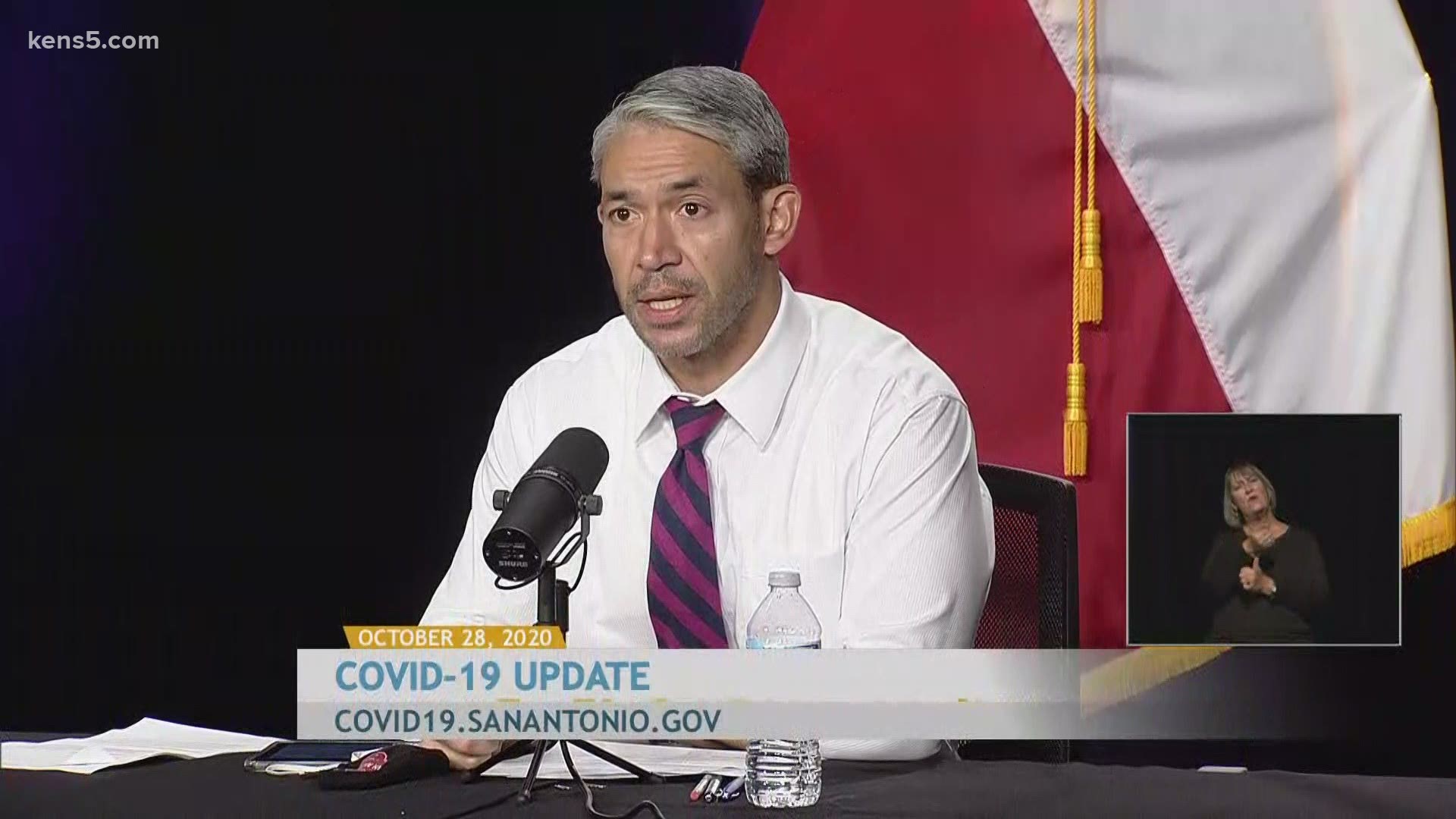SAN ANTONIO — We're tracking the latest numbers from the coronavirus pandemic in San Antonio and across Texas. Here are the latest numbers reported by Bexar and surrounding counties:
- Bexar County: 281 new cases were reported Wednesday, bringing the total number of cases for the county to 65,222. Three new deaths were also reported, bringing the county's death toll to 1,250.
- Comal County: The county reported 9 new COVID-19 cases Thursday morning. No new virus-related deaths were reported. There have been a total of 3,764 cases of COVID-19 in the county – including 2,872 lab-confirmed cases – while 120 county residents have died. County officials say there are 127 active coronavirus cases, and 3,517 residents are considered recovered.
- Hays County: Officials in Hays County on Wednesday reported six new cases in the county and no additional virus-related deaths. As of Wednesday, and after county officials provide clarification regarding "active case counts that were incorrect," there are a total of 6,103 lab-confirmed cases in the county (397 of which are active). The death toll remains at 86. 5,620 residents have recovered from the virus.
How Bexar County is trending
We've tracked how many coronavirus cases have been confirmed in Bexar County from the time officials began reporting cases in March 2020. The graphic below shows the number of cases since June and charts those daily case numbers along a 7-day moving average to provide a more accurate picture of the overall coronavirus case curve in our area and the direction we're trending amid the pandemic.
On Wednesday, San Antonio Mayor Ron Nirenberg reported 281 additional coronavirus cases in Bexar County—the highest daily total since Oct. 8.
That brings the number of diagnoses for the county to 65,222 since the pandemic began as Nirenberg stressed cooperation by everyone in the community in order to help reverse the trend of rising cases.
Nirenberg also reported three additional virus-related deaths in Bexar County, bringing the death toll to 1,250.


Despite the sharp uptick in cases, hospitalizations decreased on Wednesday to 225; that's 13 fewer, day-to-day. Forty-four patients are on ventilators, and 84 are in intensive care; both of those figures are also down slightly from Tuesday.


Coronavirus in Texas
The number of Texans who have tested positive for the coronavirus since the pandemic began grew by 5,627 on Wednesday, according to the Texas Department of State Health Services.
5,175 of those are new diagnoses over the last 24 hours, while the other 452 cases stem from a number of backlogs in several counties. More details can be found at the top of this page.
In all, at least 879,994 Texans have contracted COVID-19.


State health authorities also reported 105 additional virus-related deaths on Wednesday. At least 17,700 Texans have passed away from COVID-19 complications.
Meanwhile, COVID-19-related hospitalizations in Texas ticked up once again to 5,650, an increase of 138 from the number reported Tuesday. After the statewide hospitalizations figure declined in August and began to flatline in September, October has reversed in the trend to the wrong direction. 5,650 COVID-19-related hospitalizations is the highest that figure has been for the state since August 19.
In the last week, hospitalizations have increased by 18%. And since Oct. 1, they've risen by 77%.
Health officials warn that the state is currently in another surge. Experts attribute the spike in COVID-19 numbers to "pandemic fatigue."
The state estimates that 767,905 Texans have recovered, while 96,528 Texans remain ill with COVID-19.
Meanwhile, the Texas Education Agency updated its online coronavirus database to show that there have been 21,013 cumulative cases among staff and students across the state as of Oct. 22. More information can be found here.
The TEA releases new data on school cases every Thursday.
Latest Coronavirus Headlines
- Texans OL Max Scharping tests positive for COVID-19
- El Paso coronavirus patients are coming to San Antonio, some even by car
- Medical facilities prepare for coronavirus patients in Comal County
- Google and Apple working to help track coronavirus spread with voluntary contact tracing apps
- UT COVID-19 model suggests 100% chance that epidemic is growing
- Steps to reduce the spread of COVID-19 on Halloween
- Downtown in-person festival cancelled as coronavirus cases rise in Bexar Co.
- Pfizer CEO now expects COVID-19 vaccine results in early November
- DO YOU HAVE IT?: 'COVID Fatigue' on the rise; how to cope
- What would another surge of COVID-19 patients mean for frontline workers?
- Texas hospitals participate in statewide effort to take on coronavirus patients from El Paso
Coronavirus symptoms
The symptoms of coronavirus can be similar to the flu or a bad cold. Symptoms include fever or chills, cough, shortness of breath or difficulty breathing, fatigue, muscle or body aches, headache, new loss of taste or smell sore throat, congestion or runny nose, nausea or vomiting and diarrhea, according to the Centers for Disease Control.
Most healthy people will have mild symptoms. A study of more than 72,000 patients by the Centers for Disease Control in China showed 80 percent of the cases there were mild.
But infections can cause pneumonia, severe acute respiratory syndrome, kidney failure, and even death, according to the World Health Organization. Older people with underlying health conditions are most at risk.
But infections can cause pneumonia, severe acute respiratory syndrome, kidney failure, and even death, according to the World Health Organization. Older people with underlying health conditions are most at risk.
Experts determined there was consistent evidence these conditions increase a person's risk, regardless of age:
- Chronic kidney disease
- COPD (chronic obstructive pulmonary disease)
- Obesity (BMI of 30 or higher)
- Immunocompromised state (weakened immune system) from solid organ transplant
- Serious heart conditions, such as heart failure, coronary artery disease, or cardiomyopathies
- Sickle cell disease
- Type 2 diabetes
The CDC believes symptoms may appear anywhere from two to 14 days after being exposed.
Human coronaviruses are usually spread...
- Between people who are in close contact with one another (within about 6 feet).
- Through respiratory droplets produced when an infected person coughs, sneezes or talks. These droplets can land in the mouths or noses of people who are nearby or possibly be inhaled into the lungs.
- Some recent studies have suggested that COVID-19 may be spread by people who are not showing symptoms.
Help stop the spread of coronavirus
- Stay home when you are sick.
- Eat and sleep separately from your family members
- Use different utensils and dishes
- Cover your cough or sneeze with your arm, not your hand.
- If you use a tissue, throw it in the trash.

